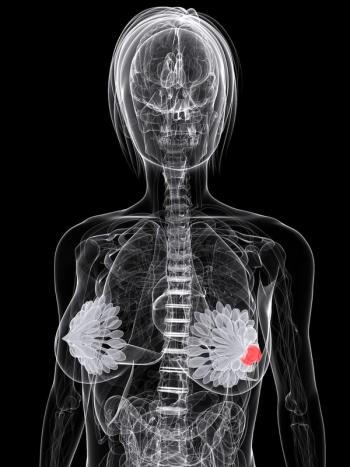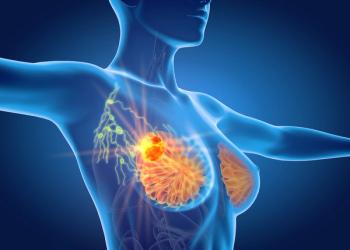
HER3-DXd Yields Activity in NSCLC, Breast Cancer Brain Metastasis Groups
Data from the phase 2 TUXEDO-3 trial support patritumab deruxtecan as a novel treatment option across different cancer populations with brain metastases.
Treatment with patritumab deruxtecan (HER3-DXd) demonstrated promising activity among patients with breast cancer and non–small cell lung cancer (NSCLC) who have active brain metastases, according to findings from cohorts 1 and 2 of the phase 2 TUXEDO-3 trial (NCT05865990) published in The Lancet Oncology.1,2
Breast Cancer Cohort
Among 21 evaluable patients in the breast cancer cohort, a confirmed intracranial response occurred in 24% (n = 5), which fulfilled the trial’s primary end point. Additionally, 29% (n = 6) of patients had partial responses (PRs), 33% (n = 7) had stable disease, and 24% (n = 5) experienced progressive disease per Response Assessment in Neuro-Oncology for Brain Metastases (RANO-BM) criteria.
Data showed a locally assessed intracranial overall response rate (ORR) of 23.8% (95% CI, 8.2%-47.1%), a bicompartmental ORR of 14.3% (95% CI, 3.1%-36.3%), and an extracranial ORR of 11.8% (95% CI, 1.5%-36.4%). Additionally, the median duration of response (DOR) was 6.7 months (95% CI, 6.0-not reached [NR]) for intracranial lesions and 5.5 months (95% CI, 5.5-NR) for extracranial lesions.
The study treatment produced a median progression-free survival (PFS) of 4.0 months (95% CI, 1.4-8.5) for intracranial lesions, 4.7 months (95% CI, 1.8-NR) for extracranial lesions, and 4.3 months (95% CI, 1.6-8.5) for bicompartmental lesions. Moreover, the median overall survival (OS) was NR at the time of analysis, as more than half of the patients in the breast cancer cohort were alive at data cutoff.
“The findings indicate antitumor activity of HER3-targeted therapy in heavily pretreated patients with active brain metastases of HER2-negative [breast] cancer, for whom local therapy remains the current standard of care. In addition, HER3-DXd showed activity after previous antibody-drug conjugates [ADCs] and irrespective of the breast cancer subtype,” lead study author Rupert Bartsch, MD, from the Department of Medicine I in the Clinical Division of Oncology at the Medical University of Vienna in Austria, wrote with coauthors in the publication.1 “Future studies of HER3-DXd with a larger sample size in the context of patients with brain metastases that focus on predictive biomarkers, ADC sequencing strategies, and multimodal approaches are warranted.”
All patients in the breast cancer cohort were female (100%), and most were White (71%) and had an ECOG performance status of 0 (62%). Additionally, most patients in this cohort had estrogen receptor–positive status (52%), progesterone receptor–negative status (62%), hormone receptor–positive status (52%), HER2-negative disease (57%), and visceral disease (67%).
Any type of adverse effect (AE) occurred in 86% of patients, with 29% experiencing serious treatment-emergent AEs (TEAEs) and 43% having grade 3/4 TEAEs. Additionally, 5% of patients had TEAEs resulting in death. TEAEs leading to dose reduction, interruption, and discontinuation occurred in 19%, 10%, and 5%, respectively.
The most common any-grade TEAEs in the breast cancer population included general disorders and administration site conditions (52%), gastrointestinal disorders (52%), nervous system disorders (48%), and blood and lymphatic system disorders (38%). Data showed 2 grade 4 TEAEs, which included individual instances of neutropenia (5%) and decreased platelet counts (5%).
NSCLC Cohort
Of 20 evaluable patients with NSCLC, 6 (30%) experienced a confirmed intracranial response, meeting the primary end point in this cohort. Additionally, 40% (n = 8) had PRs, 35% (n = 7) experienced stable disease, and 15% (n = 3) had progressive disease based on RANO-BM criteria.
Data showed a bicompartmental ORR of 25.0% (95% CI, 8.7%-49.1%), an intracranial ORR of 30.0% (95% CI, 11.9%-54.3%), and an extracranial ORR of 23.5% (95% CI, 6.8%-49.9%). The study treatment yielded a median DOR of 2.7 months (95% CI, 2.6-NR) for intracranial lesions, 7.8 months (95% CI, 2.3-NR) for extracranial lesions, and 4.1 months (95% CI, 2.6-NR) for overall lesions.
The median PFS was 4.8 months (95% CI, 2.1-NR) for intracranial lesions, 8.1 months (95% CI, 1.7-NR) for extracranial lesions, and 6.7 months (95% CI, 2.2-9.6) for overall lesions. Additionally, the median OS was 6.7 months (95% CI, 4.1-NR), with estimated OS rates of 84.4% (95% CI, 69.1%-100.0%) at 3 months and 52.9% (95% CI, 33.5%-83.6%) at 6 months.
“The results of this phase 2 trial provide evidence of substantial and clinically meaningful activity of HER3-DXd in this cohort of patients,” lead study author Thorsten Fuereder, MD, of the Department of Medicine I in the Clinical Division of Oncology at the Medical University of Vienna, wrote with coauthors regarding the NSCLC cohort.2 “The similarity between median [PFS] for bicompartmental lesions and [OS] reflects the aggressive nature of active brain metastases in this population and underscores the need to interpret these end points in the context of larger, comparative prospective trials.”
The NSCLC cohort of the TUXEDO-3 trial included an even distribution of patients who were male (50%) and female (50%); most patients were White (80%). Most of this population had an ECOG performance status of 1 (65%), nonsquamous histology (85%), advanced disease at diagnosis (70%), and visceral disease (80%).
Overall, 90% of patients experienced any AE, with 50% experiencing serious TEAEs and 65% having grade 3/4 TEAEs. Deaths associated with TEAEs occurred in 5%. Moreover, 15%, 10%, and 5% of patients required dose reductions, temporary discontinuations, and permanent discontinuations due to TEAEs, respectively.
The most common any-grade TEAEs in this cohort included gastrointestinal disorders (70%), general disorders and administration site disorders (60%), and musculoskeletal and connective tissue disorders (40%). The most common grade 4 TEAEs included neutropenia (10%), colitis (5%), febrile neutropenia (5%), thrombocytopenia (5%), hematotoxicity (5%), and decreased platelet counts (5%).
What Was the Design of TUXEDO-3?
In the international, multicenter, single-arm phase 2 TUXEDO-3 trial, patients were assigned to receive HER3-DXd at 5.6 mg/kg on day 1 of each 21-day cycle until progressive disease, unacceptable toxicity, or death. Investigators assessed the novel therapy in patients with active brain metastases from metastatic breast cancer in cohort 1, active brain metastases from advanced NSCLC in cohort 2, and leptomeningeal disease related to any solid tumor type in cohort 3.
The primary end point of cohorts 1 and 2 of the TUXEDO-3 trial was the intracranial ORR, defined as the rate of patients who experienced an intracranial complete response or PR per local investigator assessment using RANO-BM criteria. Secondary end points included extracranial and bicompartmental ORRs, clinical benefit rate, disease control rate, time to response, DOR, PFS, and OS.
References
- Bartsch R, Marhold M, Garde-Noguera J, et al. Patritumab deruxtecan (HER3-DXd) in patients with active brain metastases of breast cancer (TUXEDO-3): a multicentre, single-arm, phase 2 trial. Lancet Oncol. 2025;26(11):1467-1478. doi:10.1016/S1470-2045(25)00470-X
- Fuereder T, Garde-Noguera J, García-Mosquera JJ, et al. Patritumab deruxtecan (HER3-DXd) in patients with active brain metastases of non-small-cell lung cancer (TUXEDO-3): a multicentre, single-arm, phase 2 trial. Lancet Oncol. 2025;26(11):1454-1466. doi:10.1016/S1470-2045(25)00465-6
Newsletter
Stay up to date on recent advances in the multidisciplinary approach to cancer.

















































































